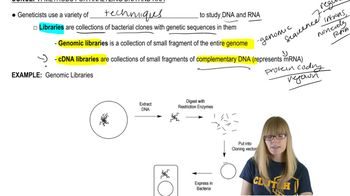Table of contents
- 1. Introduction to Genetics51m
- 2. Mendel's Laws of Inheritance3h 37m
- 3. Extensions to Mendelian Inheritance2h 41m
- 4. Genetic Mapping and Linkage2h 28m
- 5. Genetics of Bacteria and Viruses1h 21m
- 6. Chromosomal Variation1h 48m
- 7. DNA and Chromosome Structure56m
- 8. DNA Replication1h 10m
- 9. Mitosis and Meiosis1h 34m
- 10. Transcription1h 0m
- 11. Translation58m
- 12. Gene Regulation in Prokaryotes1h 19m
- 13. Gene Regulation in Eukaryotes44m
- 14. Genetic Control of Development44m
- 15. Genomes and Genomics1h 50m
- 16. Transposable Elements47m
- 17. Mutation, Repair, and Recombination1h 6m
- 18. Molecular Genetic Tools19m
- 19. Cancer Genetics29m
- 20. Quantitative Genetics1h 26m
- 21. Population Genetics50m
- 22. Evolutionary Genetics29m
18. Molecular Genetic Tools
Methods for Analyzing DNA
Problem 4a
Textbook Question
What is the statistical principle underlying genetic health risk assessment? Why are these assessments not predictive of disease occurrence?
 Verified step by step guidance
Verified step by step guidance1
Understand that genetic health risk assessments are based on the statistical principle of association, not causation. This means they identify correlations between certain genetic variants and the likelihood of developing a disease, rather than directly predicting disease occurrence.
Recognize that these assessments often use genome-wide association studies (GWAS) to identify single nucleotide polymorphisms (SNPs) associated with diseases. These studies analyze the genomes of many individuals to find common genetic variants that occur more frequently in people with a particular disease than in those without the disease.
Acknowledge that genetic risk assessments provide a probability or risk factor, not a certainty. They estimate the likelihood of developing a disease based on the presence of certain genetic markers, but they do not account for other factors such as environment, lifestyle, and interactions between multiple genes.
Consider the concept of polygenic risk scores, which aggregate the effects of many genetic variants to estimate an individual's risk of developing a disease. These scores are based on statistical models that weigh the contribution of each variant to the overall risk.
Understand that the complexity of gene-environment interactions and the multifactorial nature of most diseases mean that genetic risk assessments are not definitive. They are tools for understanding potential risk, but they cannot predict with certainty whether an individual will develop a disease.
Recommended similar problem, with video answer:
 Verified Solution
Verified SolutionThis video solution was recommended by our tutors as helpful for the problem above
Video duration:
2mPlay a video:
Was this helpful?
Key Concepts
Here are the essential concepts you must grasp in order to answer the question correctly.
Genetic Risk Assessment
Genetic risk assessment involves evaluating an individual's genetic information to estimate their likelihood of developing certain diseases. This process often utilizes statistical models that incorporate family history, genetic variants, and environmental factors to provide a risk profile. However, it is important to note that these assessments indicate probabilities rather than certainties.
Recommended video:
Guided course

Descriptive Genetics
Statistical Principles in Genetics
The statistical principles underlying genetic health risk assessments include concepts such as population genetics, heritability, and risk ratios. These principles help in understanding how genetic variations contribute to disease susceptibility within populations. They also emphasize the role of chance and environmental influences, which can complicate predictions based solely on genetic data.
Recommended video:
Guided course

History of Genetics
Limitations of Predictive Models
Despite advancements in genetic testing, assessments are not fully predictive of disease occurrence due to the complex interplay of multiple factors. Genetic predisposition is only one aspect; lifestyle, environment, and random biological events also play significant roles in disease development. Consequently, risk assessments provide insights but cannot guarantee outcomes, highlighting the multifactorial nature of health.
Recommended video:
Guided course

Sex-Linked Genes

 7:40m
7:40mWatch next
Master Methods for Analyzing DNA and RNA with a bite sized video explanation from Kylia Goodner
Start learningRelated Videos
Related Practice


